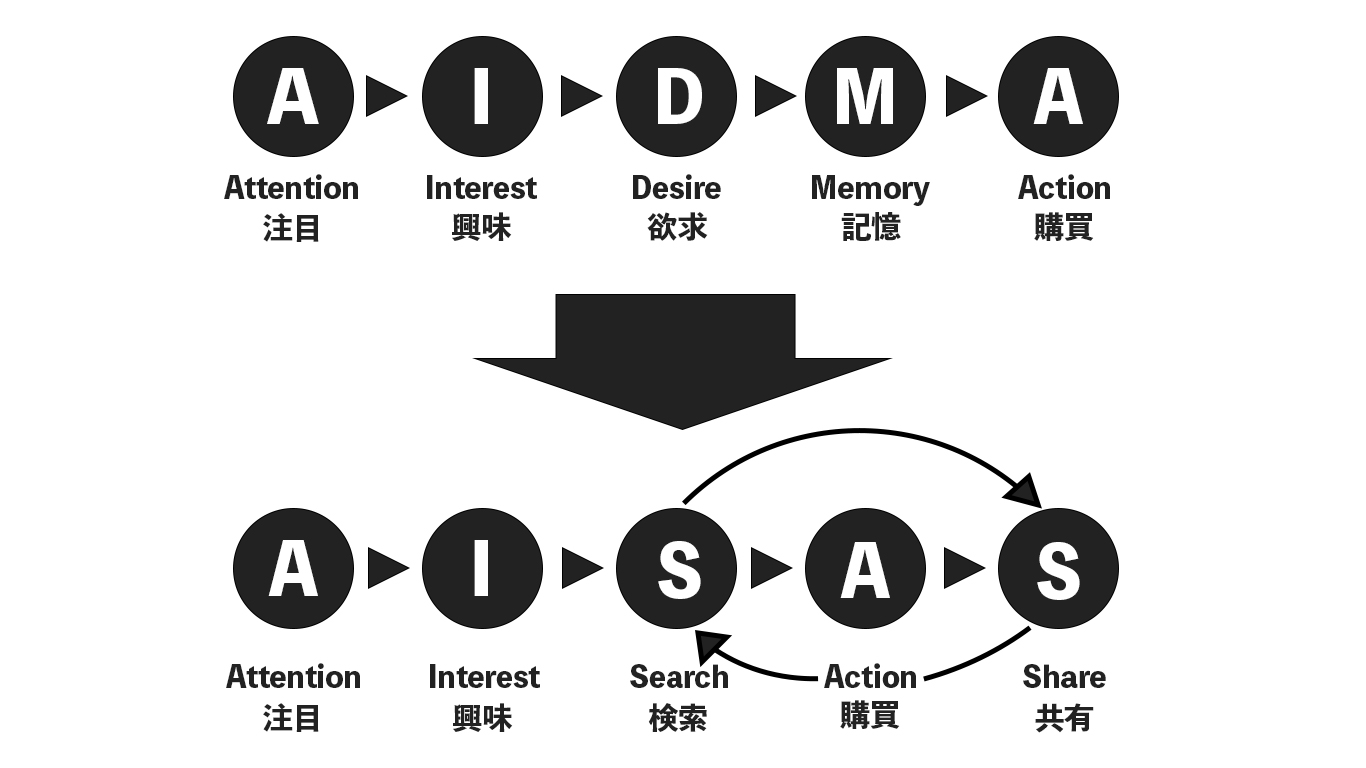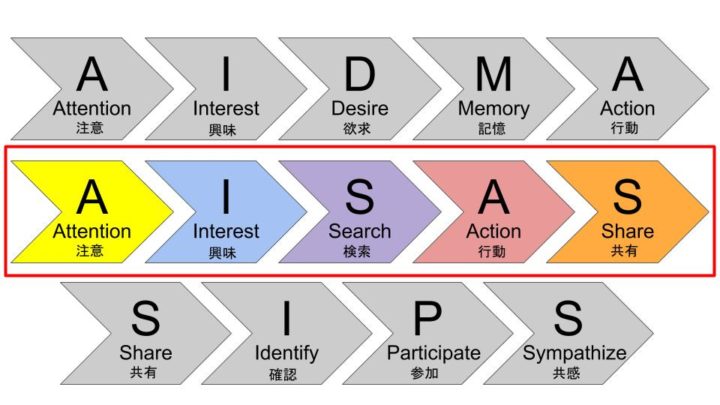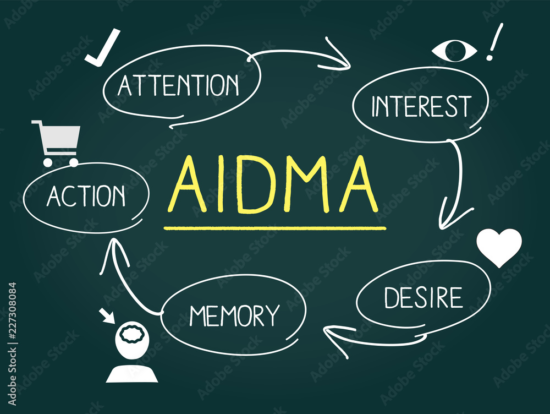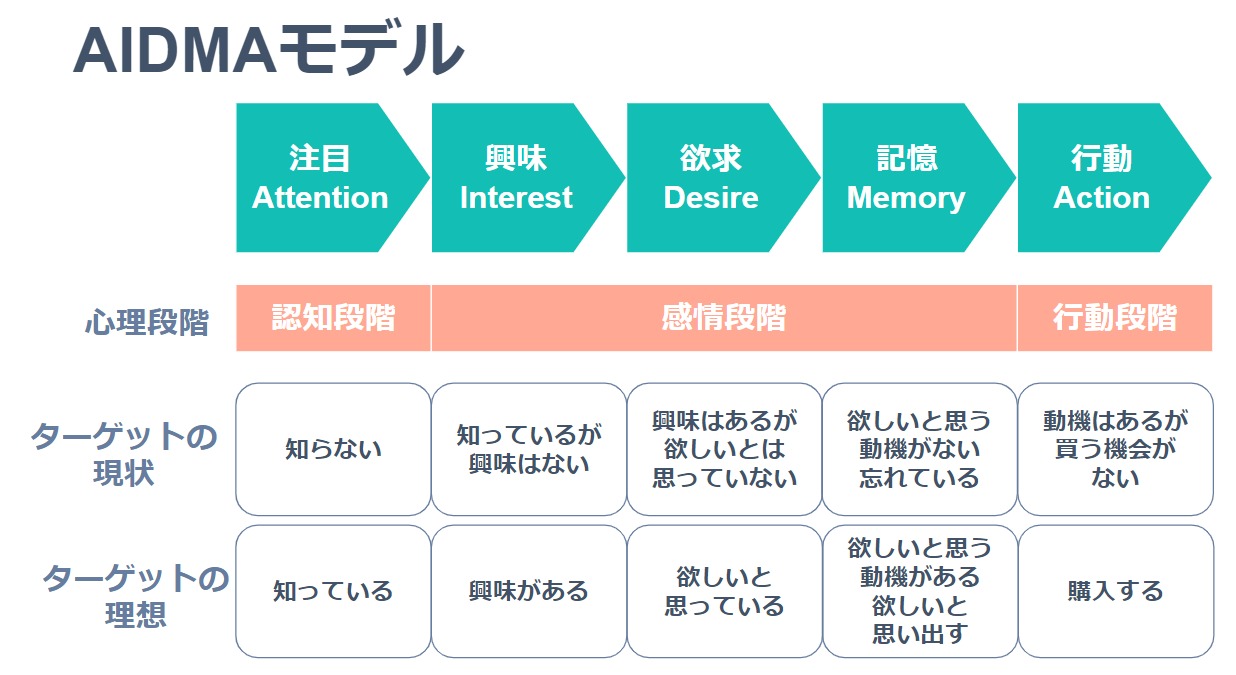When implementing marketing activities, it is essential to predict customer behavior and approach customers at the right time. To do this, you need to understand the typical customer journey to purchase.
A framework
called AIDMA is essential for understanding the general purchasing process of customers.
Therefore, this time, we will explain what AIDMA is in an easy-to-understand manner, and introduce its features and how to use it, based on the differences from similar products such as AISAS.
What is AIDMA?
AIDMA
is an acronym for “Attention, Interest, Desire, Memory, and Action.” This is one of the frameworks that models the purchasing decision process taken by customers (consumers) in the BtoC field.
Before purchasing a product or service, a customer goes through the following process:
First, customers learn about the existence of your product. This is “Attention”. Then they become interested in the product. This is “Interest”. And then they start wanting that product. This is “Desire”. If it is not possible to purchase it on the spot, it will remember the product. This is “Memory”. After that, it finally comes down to purchasing behavior. This is “Action”.
Of these five processes, it is common to divide them into three categories: attention as the “cognitive stage”, interest, desire, and memory as the “emotional stage”, and action as the “action stage”.

Psychology of each process of AIDMA ~ From a marketing perspective
In order to utilize AIDMA in marketing, it is necessary to thoroughly understand the customer psychology of each AIDMA process. Therefore, we will explain the details of customer psychology in the AIDMA process.
1.Attention (attention/cognition)
Recognize products and services
This is the stage when consumers become aware of the existence of a product or service. When it comes to purchasing in the future, it always starts with “knowing = recognizing”. Consumers become aware of the existence of products and services by obtaining information from Internet advertisements and articles, corporate SNS, TV news and information programs, etc.
2.Interest
be interested in a product or service
Even if consumers know about the existence of a product or service, nothing will happen unless they are interested in purchasing it. This is the stage in the process when consumers become interested in a product or service. People are interested in things that relate to their likes and dislikes and feelings such as “This looks good,” “This seems interesting,” “Maybe this will solve my problems or problems,” and “I want to know more.” If you have a strong level of interest, you will start collecting information on your own.
3.Desire
Increased desire to purchase products and services
With interest, consumers will learn more about the product or service. As a result, you are at the stage where you want it, want to use it, and want to try it. If you fit in perfectly with what you want, desire will be born.
4.Memory
remember the product or service
Consumers do not necessarily purchase all the products and services they want. You may not have the necessary funds available right away, or you may be thinking about the timing of your purchase for some reason. For companies, their products are still in the minds of consumers.
This is the perfect time for companies to remind consumers to actually buy their products. Providing as much information about your product or service as possible through any medium will motivate them to make a purchase.
5.Action
purchase products and services
This is the final stage of purchasing a product or service. This is the stage where the consumer takes some action, thinking, “I want to buy.” For example, visiting a store or visiting an online store. This is Action. However, I don’t know if purchases will necessarily be made here. Even when you go to the store, they may not have it in stock, or you may end up looking at other products. Also, if there are no payment methods available on the online store, you may give up on purchasing.
In marketing, it is necessary to remain vigilant even at this stage of action and take measures that will lead to purchases.

Benefits of using AIDMA for marketing
AIDMA is widely used to build marketing strategies. Because it has its benefits. Let’s take a closer look at what the benefits are.
Marketing activities that match customer behavior processes can be carried out
AIDMA represents the customer behavior process in BtoC, so by understanding AIDMA well, you can implement measures that match each timing. When implementing marketing measures, if you do not try to understand the current stage of your customers and take appropriate approaches and communication, you will miss the point completely and may not lead to purchasing behavior, or you may not be able to make a good purchase. Even if you were conscious of the direction you were heading in, you may end up losing your desire to purchase.
On the other hand, if a company can promote customers’ purchasing behavior by implementing measures that match the customer’s psychological stage in a timely manner, it will generate profits for the company.
AIDMA is important knowledge for understanding customer psychology and conducting appropriate communication.
See where customers are leaving
If you are not achieving the sales you expected, you need to know where customers are leaving or staying until they make a purchase.
An effective way to do this is to measure customer behavior, categorize it using AIDMA, and find out which processes have issues. By using AIDMA, you can discover where there are holes in your company’s activities, so you can take measures to fill them.

How to utilize AIDMA
AIDMA is a framework that has great benefits in marketing. In fact, I want to use it properly. Therefore, from now on, we will introduce how AIDMA can be used specifically, how it can be used, and its applications.
1. Use when setting personas
By using AIDMA, it becomes easier to set personas when implementing marketing measures. A persona is a typical user who buys or uses your company’s products or services. Instead of vaguely targeting a target audience such as “single women in their 30s,” set up a detailed profile as if the person actually existed. For example, you can specifically decide on your age, gender, place of residence, occupation, title, place of work, annual income, marital status, whether you have children, hobbies, values, family structure, friendships, how you spend your holidays, lifestyle, etc. I’m going.
When setting up that persona, we set specifics such as what media they get their information from and what they are interested in at the AIDMA recognition stage. By doing so, you will be able to see more specific measures for personas.
2.Be able to formulate an effective approach method according to the process
As I mentioned earlier, the advantage of using AIDMA is that it allows you to optimize the approach suitable for each process, leading to increased sales. Therefore, it is possible to strategize and formulate effective approaches that will produce results for each process of AIDMA.
Attention
Regarding attention and awareness, it is necessary to disseminate information through media tailored to the target. We will disseminate products and services through optimal media such as advertisements and SNS.
Interest
In addition to being recognized, we also need an element of interest. Think carefully about what kind of content is likely to interest your target audience, and then convey the appeal of your product or service.
Desire
Once a desire is created, consumers themselves try to collect information. You will need to improve your website and content to prepare for consumers at this stage.
Memory
Even if they are remembered, it is important to keep in mind that they may forget that your product or service exists, so it is important to remind them by placing advertisements in various media, sending periodic emails, etc.
Action
Once you’re ready to make a purchase, make your products stand out at the store and provide discount information to stimulate their desire to purchase. To avoid discouraging purchasers, online stores should have a smooth flow up to purchase, provide a variety of payment methods, and provide a collection of frequently asked questions so that questions can be quickly answered. Possible measures include:
3. Provide information at the optimal time
It is also important to provide information at the right time. AIDMA provides information to target consumers at a time that suits them. If the timing is right, it will be more beneficial to consumers and increase the likelihood that they will steadily progress through each stage of AIDMA. Use marketing automation to communicate in a well-planned manner.

AIDMA usage examples
How is AIDMA actually used? Here are two examples of how companies use it in marketing.
1. Example of hair care sales
This is an example of how a major cosmetics company sells cosmetics when selling hair care.
Attention
The TV commercial, which featured several famous actresses at the same time and had an unprecedented cast, became a big topic of conversation. The theme song also made an impact by using songs by popular idols. The content not only raised awareness, but also piqued interest.
Interest
The content praised the beauty of Japanese women and used the products to enhance that beauty, creating sympathy and envy among many people.
Desire
Such appeals naturally succeeded in increasing women’s desires. Furthermore, we encouraged people to try the product by distributing samples in stores and on street corners, which further stimulated their desire for the product.
Memory
In order to connect the interest and desire that we have attracted into purchasing behavior, we will devise measures at the store to ensure that products remain in our memories and are not forgotten. For example, we prominently displayed POP, displayed as many products as possible to appeal to customers, and sold products as a set.
Action
We encouraged purchasing behavior through a variety of developments, from all kinds of impressions to sales promotions. This series of promotions caused a sensation in Japan.
2.Example of health food sales
Next is an example of a health food sales company selling health foods to seniors.
Attention
We made an effective appeal by running a TV commercial with a song during the daytime, when the target group of seniors is often seen. There, I guided them by saying, “Please take a look at the newspaper insert.”
Interest
When I was casually looking through the newspaper, I saw an advertisement for the product in a flyer, and I thought, “Oh, that’s the product with that interesting commercial,” and I decided to take an interest in it. The features, price, effects, etc. are written in a way that can be understood at a glance, and the product attracted a lot of attention.
Desire
The insert flyer also features testimonials such as “I felt better after drinking this,” and consumers who had similar problems thought, “Maybe this will help me,” and their desire to purchase increased. It stirred up. Additionally, by offering a discount for first-time users, we increased the desire of those who were unsure about the effectiveness of the product.
Memory
By continuing to make impactful appeals through repeated commercials and flyers, we compensated for the waning desire to purchase.
Action
Although sales were primarily conducted over the Internet, we assumed that there would be seniors who were unfamiliar with operations, so we began accepting orders by phone or fax.

Summary of specific measures in AIDMA
So far, we have looked at how to utilize AIDMA and examples, but I think we now have a somewhat clear idea of what kind of marketing measures should be taken in each process of AIDMA. Here, we will specifically summarize what measures are effective in each process. Please use it when planning your marketing strategy.
1.Attention (attention/cognition)
- Dissemination and dissemination of information online such as Internet advertising, website content, email newsletters, and SNS.
- Dissemination and dissemination of information through advertising media such as TV commercials, newspaper inserts, transportation advertisements, and Internet advertisements.
- Select the media most familiar to your target audience.
- Increase attention and interest at the same time by developing impactful advertising content.
2.Interest
- When disseminating information using a medium similar to Attention, appeal to the appeal of products and services that are likely to interest the target.
- Increase interest by utilizing cross-media such as TV commercials and insert flyers.
3.Desire
- Prepare a variety of detailed information on products and services and related knowledge for consumers who collect information on their own. Enhancing website content, etc.
- Encourage use by distributing samples in stores and on street corners, and offering free samples online.
- A discount will be given to first-time users.
4.Memory
- Continue to appeal to consumers through all types of media so as not to undermine consumers’ desire to purchase.
- Disseminate advantageous information such as coupon offers and discount information to stimulate purchasing intent.
- Send regular emails and reminders.
- At stores, products are promoted using POP, etc.
5.Action
- Ensure sufficient inventory at stores.
- At stores, we encourage purchases by distributing coupons and selling discounted sets.
- The online store will ensure sufficient inventory and provide payment methods to ensure smooth purchasing.
- Prepare a collection of Frequently Asked Questions so that customers can quickly answer any questions they may have.
- Depending on the target audience, we accept not only online purchases but also orders by phone or fax.

Is AIDMA outdated?
By the way, recently, the AIDMA framework has come to be said to be outdated. AIDMA is a concept that was born in the early 20th century, when the word marketing began to gain attention. Therefore, consumer behavior also adapts to the environment at the time.
The reason why it is said to be outdated is because the behavior of general consumers has changed due to the spread of the Internet. For this reason, several frameworks, including AISAS, are attracting attention as consumer behavior models that take into account the Internet and SNS, etc., which are suitable for the current era.

What is the difference between AIDMA and AISAS?
Let’s check how AISAS, which we introduced earlier, differs from AIDMA.
AISAS
is a new framework that follows the processes of Attention, Interest, Search, Action, and Share.
Recently, it is common for consumers to search and collect the information they want to know when they have AIDMA’s Attention or Interest. We collect information in every way possible, including detailed explanations about the product, word of mouth, and comparisons with other similar products through internet search engines, SNS, and communication with acquaintances through chat tools.
In addition, there are many cases in which Desire is followed by Action immediately without taking the step of Memory, and then there is a Share activity to share one’s experience on SNS etc. That’s what I do.

AISAS marketing usage example
Here, we would like to introduce one case study where AISAS was used successfully in marketing. This is an example of a famous coffee chain.
1.Attention (attention/cognition)
This coffee chain has a basic policy of not running TV commercials or internet advertisements. Even so, every time a new menu or product comes out, the information spreads all over the internet in an instant, and many people become aware of it.
For example, a company might publish news about launching a new seasonal menu. At the same time, we will also disseminate information on the official SNS page. Then, consumer fans and mass media will quickly notice and spread the information. When a consumer sees such information, it leads to attention.
2.Interest
Consumers become interested when they see good-looking photos and delicious-looking cafe menus on social media. Many people are also interested in whether the coffee chain has released a new menu.
3.Search
For those who are really interested, what is this new menu like? I’m curious and looking for any information. Search using various methods such as search engines and SNS.
4.Action
As a result of the search, consumers who decide they want to try the new menu stop by the cafe and purchase the new menu item.
5.Share
However, purchasing and drinking is not the end. People tend to take pictures to post on SNS before drinking. The user then posts the photo along with their impressions and shares it on social media. When other consumers see this, they take AISAS action again.
This is a great example of AISAS creating a virtuous cycle in a natural way.

Let’s also know the difference between AISCES, SIPS, and DECAX
In addition to AIDMA and AISAS, frameworks such as AISCES, SIPS, and DECAX are also attracting attention. Let’s check what each means.
AISCEAS
AISCEAS is an acronym for Attention, Interest, Search, Comparison, Examination, Action, and Share. The meanings are said to be almost the same.
Comparison and Examination have been added to AISAS, and these also represent the process by which consumers (customers) perform purchasing actions using the Internet. Indicates that you will compare or consider after searching.
SIPS
SIPS is a framework that has been used since the spread of SNS. It is an acronym for Sympathize, Identify, Participate, and Share & Spread. First, on SNS, consumers find something that interests them and empathize with it. Take action to confirm what kind of product it is and whether it is something you can buy. Next, participation does not mean making a direct purchase, but rather participating in SNS by retweeting or sharing. People who see the post will then share and spread the word. Because there is no purchasing behavior, it is called a “consumer consumption behavior model” rather than a “purchasing behavior process,” but it can also be said to be a typical behavior of consumers that is important these days. Therefore, it can be used for marketing activities.
DECAX
DECAX is a new era purchasing behavior process framework that also takes into consideration SNS. It is an acronym for Discovery, Engagement, Check, Action, and eXperience.
First, discover content on the internet or SNS. Then, engage with them by following the companies and influencers who are transmitting this information. While building relationships in this way, if it’s a company, check out the products and services that company offers. Eventually, you will end up purchasing the product. After that, share your experience of purchasing the product on social media.
DECAX is said to be a purchasing behavior process that corresponds to corporate content marketing.
Together with AIDMA, let’s combine these modern consumer behavior models and utilize them in our marketing activities.
summary
AIDMA is an acronym for “Attention, Interest, Desire, Memory, Action” and is a framework that models the purchasing decision process taken by customers (consumers) in the BtoC field.
The benefits of using AIDMA for marketing include being able to conduct marketing activities that match the customer behavior process, and being able to see where customers are leaving.
AIDMA can be used in the following ways: 1. It can be used when setting personas, 2. It can formulate effective approaches according to processes, and 3. It can provide information at the optimal timing.
With the spread of the Internet, the AIDMA framework is now considered obsolete. Therefore, in recent years, frameworks such as AISAS, AISCES, SIPS, and DECAX, which are designed for the Internet and SNS, have been attracting attention.



